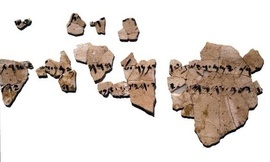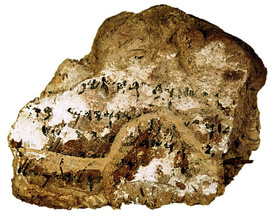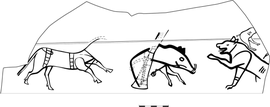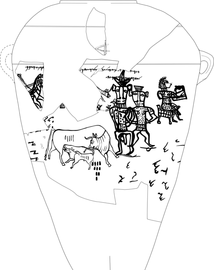LINK A strange drawing found in Sinai could undermine our entire idea of Judaism - Israel News - Haaretz.com
Is that a 3,000-year-old picture of god, his penis and his wife depicted by early Jews at Kuntillet Ajrud?
Nir Hasson
04.04.2018 | 11:26
More than four decades after its excavation wound down, a small hill in the Sinai Desert continues to bedevil archaeologists. The extraordinary discoveries made at Kuntillet Ajrud, an otherwise nondescript slope in the northern Sinai, seem to undermine one of the foundations of Judaism as we know it.
Then, it seems, "the Lord our God” wasn't “one God.” He may have even had a wife, going by the completely unique "portrait" of the Jewish deity that archaeologists found at the site, which may well be the only existing depiction of YHWH.
Kuntillet Ajrud got its name, meaning “the isolated hill of the water sources," from wells at the foot of the hill. It is a remote spot in the heart of the desert, far from any town or or trade route. But for a short time around 3,000 years ago, it served as a small way station.
Dozens of drawings and inscriptions, resembling nothing whatever found anywhere else in our region, survived from that period, which seems to have lasted no longer than two or three decades. Egypt gained the artifacts with the peace treaty with Israel 25 years ago, but the release of the report on the excavation six years ago and a book about the site two years ago have kept the argument over the exceptional findings from the hill in Sinai alive.
The hill lies 50 kilometers south of Kadesh Barnea and 15 kilometers west of the ancient Darb el-Ghazza route, which led from Gaza to the Read Sea's Gulf of Eilat. Its unique qualities were first noticed in 1870 by the British explorer Edward Palmer who discovered a fragment of a clay jar, a pithos, marked with the Hebrew letter aleph.
Later, in 1902, a Czech orientalist and explorer, Alois Musil, was attacked by local Bedouins who claimed that he was defiling a holy site. Exploration would only resume in 1975, by the Tel Aviv University archaeologist Ze’ev Meshel, as part of a collaboration between the university and the Israel Exploration Society.
The excavation showed that Kuntillat Ajrud was what's called a "single-layer site," meaning, it had been occupied for just one period, which the excavators dated to the late ninth century or early eighth century B.C.E.
Meshel estimated that it had been occupied very briefly, 25 years at most. Structure-wise, the excavators only found two fairly simple, unimpressive structures. The wonder lay in the drawings and inscriptions.
Clay from Jerusalem
At first the archaeologists thought that the place was a military fortress. Other fortresses from the First Temple period had been found in the Negev. But no evidence that there had been a military presence was found, and in the third excavation season, Meshel decided that the structures weren't that sort.
Nor would Kuntillet Ajrud have been suitable as an inn for travelers: it was too small and was off the beaten track. Nor did it seem to match any of the criteria of a trade station.
The first hint at the true character of Kuntillet Ajrud was the discovery of pottery fragments inscribed with ancient Hebrew letters: quf, quf resh, aleph and yud.
Analysis of the clay from which the pithos (pottery jars) was intriguing. The pots were made of hawar motza, clay only found by Jerusalem. In other words, the jars had been made in area of Jerusalem, which was certainly far away.
Among the inscriptions were a blessing and religious texts. That and the origin of the clay suggested to Meshel that the residents were priests and Levites, who were supported by tithes collected in the Temple in Jerusalem.
In line with the spirit of this interpretation, he also interpreted the letters on the dishes: quf as standing for kodesh (holy), quf-resh as the first two letters in the word korban (sacrifice), and aleph for a korban asham (guilt offering).
The letter yud, Meshel suggests, may represent a vessel that had been used to continued tithes, though he himself casts doubt on that theory: “In First Temple times, they used Egyptian numbers,” he points out.
Another inscription found there argues that the hill had been peopled by a literate elite and even hints at the presence of a school. One vessel contains the Hebrew alphabet twice — one in the crisp, competent handwriting of a well-trained scribe and another in what researchers suspect was the hesitant handwriting of a student.
If all this is true, what was a small group of priests and Levites doing in the middle of the desert?
When King Yoash conquered Judah
Meshel thinks the people dwelling at the site were providing an essential service: writing blessings. But from who, for who? The story gets even more complicated when one examines the site through the lens of geopolitics.
At the time the hill was occupied, the kingdom of Israel existed in the north, ruled from Samaria. The kingdom of Judah existed in the south and had its capital in Jerusalem.
However, the names and inscriptions found at Kuntillat Ajrud seem to be Israelite, not Judahite. It seems to have been an Israelite site — far, far to the south of Israel and even south of the Judah border.
Why would one kingdom maintain a religious site at the far end of another kingdom?
Meshel thinks the Israelite presence in or beyond the Judean kingdom, and the fact that Jerusalem (the capital of Judah) provisioned this way station of the rival kingdom, indicates that at the time the kingdom of Israel was, or was turning into, a regional power.
Judah was a vassal state subject to the more powerful northern kingdom, he thinks.
As for why Judahite Jerusalem would provision this Israelite-manned hilltop in the middle of nowhere, Meshel suspects it all comes down to Kuntillat Ajrud having been founded by none other than King Yoash of Israel.
“The bible says that war broke out between Amatzia, king of Judah, and Yoash, king of Israel,” he says. Thus the Israelite king Yoash gained control of Judah.
It would have been convenient for Yoash to provision Kuntillat Ajrud from the Temple in Judah. Why would he have sent up north to bring supplies for it from Israel, Meshel asks rhetorically.
If indeed Meshel is right and King Yoash founded the site, he may be the figure drawn on plaster at the entrance of the building.
The drawing, possibly of the king, was restored by Prof. Pirhiya Bar based on similar drawings from the ancient east, in which the royal figure holds a lotus flower. It is a reasonable possibility that the figure depicted at Kuntillet Ajrud was a ruler or king, and if so, then it is the only contemporary visual description we have of a king from biblical times.
“I told myself look at the luck I had, finding the only drawing of a king from the First Temple period,” says Meshel.
A picture of God, and is that his tail
Kuntillet Ajrud also brought images of animals, humans and what seems to be gods.
The one causing the controversy shows a man and a women, drawn naively, with crowned heads and holding hands. The man has either a tail or a large penis, and above him the blessing “Yahweh and his Asherah” is written.
Could the couple on the pithos be a rendering of God and his wife Asherah, the only one ever found?
Dr. Yigal Bin Nun, a researcher and author of “A Brief History of YHWH.” has no doubt. “If you want to step away from reality then you can say this or that, but if you look at it as it is you can’t ignore the truth,” he says.
Among the detractors are Prof. Tallay Ornan, who has studied the images at the site, and Prof. Shmuel Ahituv, an acclaimed ancient inscriptions researcher. Both contributed to a book on the topic together with Meshel and Esther Eshel, published last year.
They think these figures show the minor Egyptian deity Bes, not YHWH, the Jewish god.
“Bes is a dwarf who was the deity of witches," Ahituv says, adding that in his view, the picture shown wouldn't befit a major divinity.
Defending the picture as that of YHWH, Ben Nun an Israelite religious site on the border of Judah, under the political auspices of Assyria, would be unlikely to hail Bes, or any Egyptian god or symbol. Egypt was considered hostile. "The Bes explanation is completely illogical," Ben Nun says.
Furthermore, it's hard to make sense of the writing “YHWH and his Asherah” without suspecting that this god, at least according to the people on this hill, was married.
God of the south and god of the north
Other phrases found at the site also challenge the known pantheon of Israelite faith. “Yahweh of Teman and his Asherah” and “Yahweh of Samaria and his Asherah,” for example, were also found inscribed at the site.
These are doubly outrageous. If God is one, then how can there be god for the north (Shomron) and for the south (Yemen, still called Teman in Hebrew)?
To make matters worse, does the word “Asherah,” formulated as “his Asherah”, hint that the gods of Israel had a wife? If so, where has she gone?
For Meshel, the site’s main researcher, the issue remains unresolved.
He and Ben Nun suspect the site brings insight to the beliefs of the people living here 3,000 years ago. They did not worship a single al-powerful deity: they were devoted to a pantheon of gods.
It has also long been known that households with Jewish hallmarks, certainly in the First Temple era and later too, also had images of other gods, a.k.a, figurines.
If anything the discoveries at Kuntillet Ajrud indicate that in the late ninth century B.C.E. or the early eighth, the idea of a single deity had not yet consolidated, suggests Meshel. "In this religious reality YHWH is local, for the city, the village, for Shomron and for Teman (Yemen)."
Ashera the tree?
The sheer fact that Kuntillet Ajrud was so far-flung is what enabled it to survive, Meshel further claims - albeit not for long.
Come the seventh century B.C.E., Josiah King of Judah spearheaded a profound religious reformation, that included centralizing ritual sacrifice in Jerusalem and destroying competing sites.
By that time, Kuntillet Ajrud was long since abandoned. Meshel suspects the kingdom simply forgot about it.
Ahituv rejects this whole analysis and thinks that Ashera referred to a tree. Or maybe a thing or place. But not an independent female divinity.
“If you look at the Bible you can see that there is no sacrifice for Ashera - but rather the ashera is chopped down ahead of war," he says. "It may be a tree but it was not an independent being."
Regarding the varying names of Jehovah, Ahituv says these are different manifestations of the same god, “its like there are different manifestations of the Holy Mary in different places and everyone knows it’s the same Mary.”
Meshel does not agree: “If you read the phrase as is, clearly the meaning is that she is his partner.”
“The Bible reads: Ashera pesel (Ashera statue) — the statue had to represent someone. We can’t just say it was a log,” Ben Nun bolsters the point. Some also believe the early Jews worshipped trees.
This argument is bound to continue even though access to the actual findings is impossible. As part of the deal with Egypt, all archaeological findings were returned to Cairo in 1993. They have not been shown to the public since then. Meshel fears Kuntillet Ajrud will be forgotten again.
Pictures:
- Depiction of god and his wife? Found at Kuntillet Ajrud
- Kuntillet Ajrud.
- Ancient Hebrew writing found at Kuntillet Ajrud
- Animal images found at Kuntillet Ajrud
- Depiction of god and his wife? Found at Kuntillet Ajrud
- Reconstruction of what may be the image of King Yoash, possibly the only known contemporary portrait of a Judahite king. Found at Kuntillet Ajrud
- map
- Kuntillet Ajrud
- Kuntillet Ajrud
- Ancient Hebrew writing on the rim of a bowl found at Kuntillet Ajrud, dating to about 3,000 years ago

Enjoy being online again!
Welcome to the community of good people who base their values on evidence and appreciate civil discourse - the social network you will enjoy.Create your free account
7 comments
Feel free to reply to any comment by clicking the "Reply" button.Really interesting article. I mean that.
But, I can't stop laughing. Seriously Everytime I see this picture in my head I chuckle, laugh or giggle. I read this hours ago. It is still busting me up.
OMG. It has a laundry list of funny going on.
First, Christ apparently has a brother from another mother. God is hung like a horse. God apparently lives in patriarchal heaven where he raises the kid and handles things while mother god rides around in a shopping cart reading the news paper.
Then there is the picture quality. It seriously reminds me of Picasso. Except, lacking any cubist techniques.
I keep laughing at different imagined scenarios where this picture is revealed to religious nut bags.
OMG! Can you imagine some priest explaining to his/her congrigation this picture. Telling them that there is exciting news. The oldest artwork depicting God has been found. It was drawn over 3000 years ago. Then the leader tells the congregation that it is about to be unveiled on the overhead screen. There all so excited to see an old picture of God and then that picture pops up. Their like wtf.
Thanks for sharing. Made my day.
Sorry dude, old news, besides who gives a fuck about inexisting crap?
@Gwendolyn2018 because this site is a forum for posting opinions, and that is my opinion, i don't give a fuck about inexisting things and this site is full of people who also do not give a fuck about religion, all made up things that do not exist. I ask you, who is the elitist here, the one who opines or the one who wants to become the posting police? Now fuck off!
@Gwendolyn2018 then don't and follow your own example, move on. Did the word decorum mean anything to you when you disagreed with my opinion and also used the same word that now you find so icky-poo? Puhleeze go bitch to someone who gives a fuck, I don't.
Ashera worship was still going on in Nineveh at the time of Jeremiah and Jonah as both preached against worship of her, though in earlier times she had been the consort of YHWH and was a fertility godess, praised in the form of a long wooden phallic poles, that have been consistently discovered for decades despite the efforts of generations of male "holy" men to destroy them all.
Interesting but nothing really new here. See the work of Francesca Stavrakopoulou.
YHWH was never a sole god until after the Babylonian exile and Abraham and his father were idol makers apparently, identifying that there wasn’t one god celebrated in Bronze Age desert cultures.
I’m no expert but I also understand that most gods had partners.
Thanks for sharing the article.
Enjoy being online again!
Welcome to the community of good people who base their values on evidence and appreciate civil discourse - the social network you will enjoy.Create your free account
Share this post
Categories
Agnostic does not evaluate or guarantee the accuracy of any content. Read full disclaimer.

















